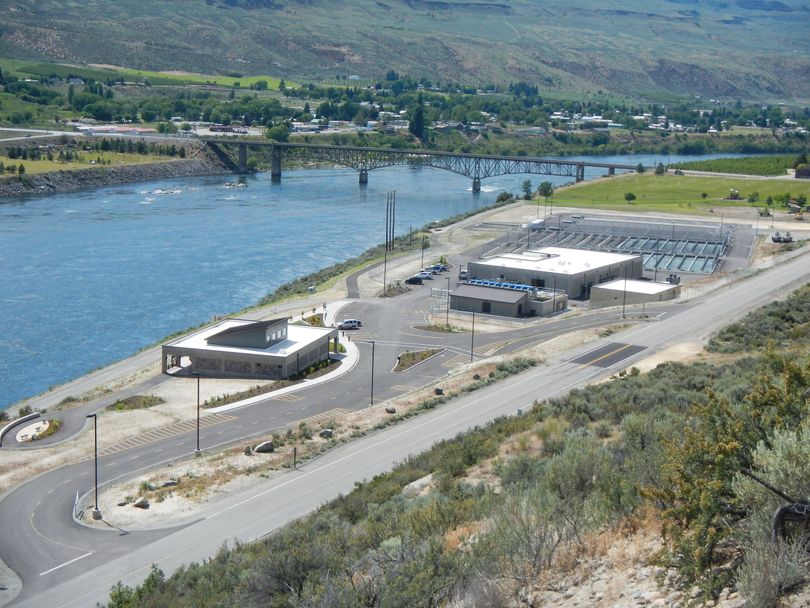Colville Tribe opens $51 million salmon hatchery

FISHING -- The new Chief Joseph fish hatchery that will release nearly 3 million salmon to the wild each year is being dedicated today along the Columbia River in north-central Washington new Brewster, marking the opening of the first hatchery designed and built under new scientific recommendations intended to boost fish survival rates in the Pacific Northwest.
A new fish hatchery that will release nearly 3 million salmon to the wild each year is set to be dedicated Thursday in rural north-central Washington, marking the opening of the first hatchery designed and built under new scientific recommendations intended to boost fish survival rates in the Pacific Northwest.
The $51 million hatchery near Chief Joseph Dam will help to rebuild naturally occurring spawning salmon runs in areas where they were damaged by the construction and operation of Columbia River hydropower dams and allow for the reintroduction of one species - spring chinook - in the Okanogan River, where they were extirpated decades ago.
In turn, the hatchery will boost opportunities for salmon harvests for members of the Colville Confederated Tribes, who retain fishing rights in the region but have seen the supply of fish dwindle with construction of the dams, and for sport fishing.
"This will restore a population of fish so that the tribe can increase harvest, supplying them with more fish and getting it back into their diet in a meaningful way," said Pat Phillips, the tribes' hatchery manager.
There are more than 400 dams in the Columbia River Basin, which stretches south from the river's headwaters in Canada across Washington, Oregon, Idaho and Montana, blocking passage for Pacific salmon and other anadromous fish that mature in the ocean and return to their native rivers and streams to spawn.
Fish ladders have been added to dams to try to improve survival rates, but they are not available at all dams. On the Columbia itself, fish passage ends at Chief Joseph Dam just south of the Colville reservation.
The hatchery's goal is to release 2.9 million fish annually - 2 million summer chinook and 900,000 spring chinook. All will be marked as hatchery fish and be subject to harvest in the Columbia River and in the Pacific Ocean.
In 2009, a scientific review panel released recommendations after a multi-year review, mandated by Congress, to improve hatchery operations throughout the Pacific Northwest. The review evaluated everything from fish stocks to water temperature and flows to geographic releases of fish.
Existing hatcheries were able to make some small changes to their operations, and a few hatcheries that were under construction while the review was in progress adopted suggestions, Phillips said. But wholesale changes to operations simply weren't possible at most hatcheries.
The Chief Joseph Hatchery is the first designed and built under those recommendations, he said.
Under the recommendations, the hatchery will draw water from the reservoir behind the dam, Rufus Woods Lake, to ensure that water temperatures fluctuate as they would for fish in the wild.
Fish reared in hatcheries that draw well water, which can be too warm in the winter months, have a higher incidence of "jacking," where the fish mature too quickly. Those fish tend to cut short their stay in the ocean, returning in two or three years instead of the normal three to five years, and they tend to predominantly become male fish, hurting reproduction efforts.
"The bash against hatcheries has always been that they're just production facilities and they don't replicate nature," Phillips said. "Improving operations is the right thing to do to increase survival rates and ultimately increase reproduction."
The tribes will operate the hatchery, which was built in partnership with the U.S. Army Corp of Engineers, the Bonneville Power Administration, Grant County Public Utility District and the Northwest Power and Conservation Council under a 2008 agreement to improve salmon recovery efforts.
Across the Northwest, tribes have worked with state and federal agencies to champion reintroduction of lost species of fish. The Yakama Nation has spearheaded the recovery of sockeye, coho salmon and summer chinook across central Washington. And in Oregon, the Confederated Tribes of the Umatilla successfully restored spring chinook salmon to the Umatilla River and are now working to replicate that success in southeast Washington's Walla Walla River basin.
Read more here: http://www.thenewstribune.com/2013/06/20/2646087/colville-tribes-open-51-million.html#storylink=cpy